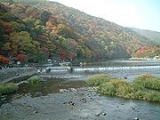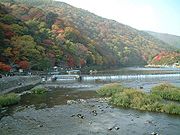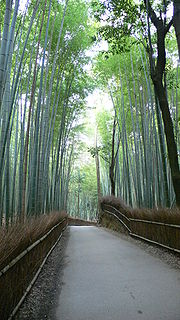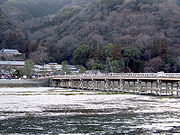
Arashiyama
Encyclopedia



Kyoto
is a city in the central part of the island of Honshū, Japan. It has a population close to 1.5 million. Formerly the imperial capital of Japan, it is now the capital of Kyoto Prefecture, as well as a major part of the Osaka-Kobe-Kyoto metropolitan area.-History:...
, Japan
Japan
Japan is an island nation in East Asia. Located in the Pacific Ocean, it lies to the east of the Sea of Japan, China, North Korea, South Korea and Russia, stretching from the Sea of Okhotsk in the north to the East China Sea and Taiwan in the south...
. It also refers to the mountain across the Ōi River
Katsura River
The is a continuation of two other rivers, the Hozu River, a small, speedy river which begins in the mountains near Kameoka and then slithers through the mountains separating Kameoka and Kyoto; and the Ōi River , which emerges from those mountains and expands into a shallow, slow-flowing river...
, which forms a backdrop to the district.
Notable tourist sites in Arashiyama include
- The Iwatayama Monkey ParkIwatayama Monkey ParkIwatayama Monkey Park is a commercial park located in Arashiyama in Kyoto, Japan. The park is on Mt Arashiyama, on the same side of the Oi River as the train station. It is inhabited by a troop of over 170 Japanese macaque monkeys...
on the slopes of Mount Arashiyama. Over 170 monkeys live at the park. While the monkeys are wild, they have become accustomed to humans. The park is located on a small mountain not far from the Saga-Arashiyama rail station. Visitors can approach and photograph the monkeys. At the summit is a fenced enclosure, from within which visitors can feed the monkeys. - The romantic "Moon Crossing Bridge" (渡月橋,Togetsukyō), notable for its views of cherry blossoms and autumn colors on the slopes of Mt Arashiyama.
- The tombstone of the Heike courtesan Kogo of Sagano.
- Tenryū-jiTenryu-ji—more formally known as —is the head temple of the Tenryū branch of Rinzai Zen Buddhism, located in Susukinobaba-chō, Ukyō Ward, Kyoto, Japan. The temple was founded by Ashikaga Takauji in 1339, primarily to venerate Gautama Buddha, and its first chief priest was Musō Soseki. Construction was...
, the main temple of one the 15 branches of the Rinzai school, one of the two main sects of Zen Buddhism in Japan. - The hamlet of Kiyotaki, a small scenic village at the base of Mt Atago, the home to a notable Shinto shrine.
- Matsuo Shrine, half a mile south of the area, which is home to a blessed spring. It is also one of the oldest shrines in the Kyoto area, founded in 700. The alleged restorative properties of the spring bring many local sake and misoMisois a traditional Japanese seasoning produced by fermenting rice, barley and/or soybeans, with salt and the fungus , the most typical miso being made with soy. The result is a thick paste used for sauces and spreads, pickling vegetables or meats, and mixing with dashi soup stock to serve as miso...
companies to the shrine for prayers that their product will be blessed. - Kameyama koen has a stone commemorating Zhou Enlai'sZhou EnlaiZhou Enlai was the first Premier of the People's Republic of China, serving from October 1949 until his death in January 1976...
visit to Arashiyama. He was moved by the cherry blossoms and mountain greenery. The four poems Zhou Enlai wrote about his visit are engraved on a stone monument: "Arashiyama in the Rain." - Ōkōchi SansōŌkōchi Sansōis the former home and garden of the Japanese jidaigeki film actor Denjirō Ōkōchi and is located in Arashiyama, Kyoto. The villa is open to the public for an admission fee and is known for its gardens and views of the Kyoto area. Several of the buildings are recorded as cultural properties by the...
, the Japanese-style home and gardens of the film actor Denjirō ŌkōchiDenjirō Ōkōchiwas a Japanese film actor most famous for starring roles in jidaigeki directed by such masters as Akira Kurosawa, Daisuke Itō, Sadao Yamanaka, Teinosuke Kinugasa, Hiroshi Inagaki and Masahiro Makino. His real name was Masuo Ōbe...
.
Transport
Arashiyama is accessible by the Keifuku Electric RailroadKeifuku Electric Railroad
is a railroad company based in Kyoto Prefecture, Japan in operation since March 2, 1942. It is a parent company of Keifuku Bus, and an affiliated company of Keihan Electric Railway, which owns 42.89% of the company stock...
from central Kyoto or by the Hankyū Arashiyama Line
Hankyu Arashiyama Line
is a railway line in Kyoto, Japan, operated by Hankyu Railway. It runs between Katsura and Arashiyama on the west side of the city, connecting the area along the line to the Hankyū Kyōto Main Line that runs east to central Kyoto and south to Osaka....
from Osaka
Osaka
is a city in the Kansai region of Japan's main island of Honshu, a designated city under the Local Autonomy Law, the capital city of Osaka Prefecture and also the biggest part of Keihanshin area, which is represented by three major cities of Japan, Kyoto, Osaka and Kobe...
. Additionally, the JR
JR
Jr. is the abbreviation for Junior.For articles named Junior;, see Junior JR may also stand for:-People:* Jackie Robinson , an American Major League Baseball player...
Saga Arashiyama Station is located in the district's suburbs.
Togetsukyō

Hozu River
The is a part of Katsura River in Kyoto Prefecture, Japan. The river begins in the mountains near Kameoka, a town northwest of Kyoto City. It snakes into the Arashiyama section of western Kyoto before changing its name to Katsura River....
and east of the bridge it is the Katsura River
Katsura River
The is a continuation of two other rivers, the Hozu River, a small, speedy river which begins in the mountains near Kameoka and then slithers through the mountains separating Kameoka and Kyoto; and the Ōi River , which emerges from those mountains and expands into a shallow, slow-flowing river...
.
External links
- Pictures of Kyoto, Arashiyama (including Sagano, Katsura river, Takebayashi Street)
35.015096°N 135.670667°W (Arashiyama Park)
35.012864°N 135.67775°W (Togetsukyō)
35.018761°N 135.681389°W (JR Station)
35.015437°N 135.678306°W (Randen Station)
35.009859°N 135.682347°W (Hankyū Station)

